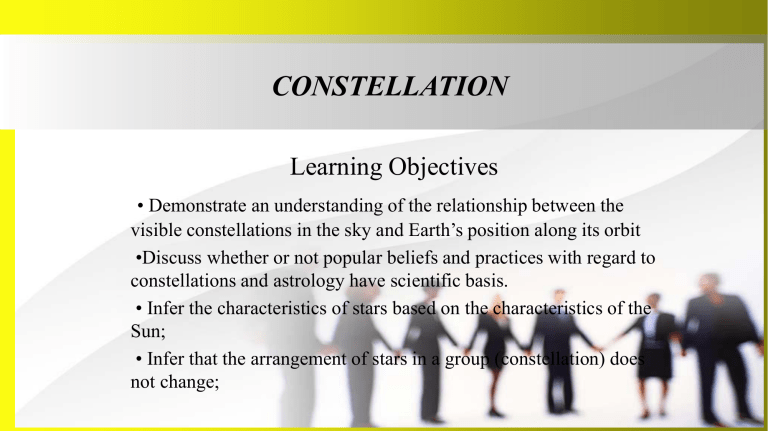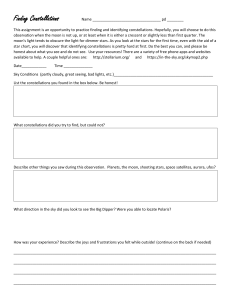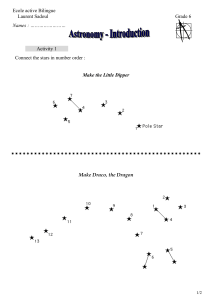
CONSTELLATION Learning Objectives • Demonstrate an understanding of the relationship between the visible constellations in the sky and Earth’s position along its orbit •Discuss whether or not popular beliefs and practices with regard to constellations and astrology have scientific basis. • Infer the characteristics of stars based on the characteristics of the Sun; • Infer that the arrangement of stars in a group (constellation) does not change; What are stars? Star is a massive ball of plasma held together by its own gravity and emits light throughout the universe. In what ways can constellation be useful to people? Constellations are useful because they help stargazers and astronomers recognise specific stars in the night sky. Constellations were used as proper calendars when it came to agricultural purposes. People had no proper way to determine when to sow or harvest except by looking at stars. Constellations were also used for navigation and to help sailors travel across oceans. What are some beliefs and practices about constellation and astrology? Constellations also caught the interests of Chinese and Japanese. Some patterns of stars after animals such as Fish, Scorpio, Lion and among others. Ancient people used constellations for religious purposes. Best example is Mesopotamian astral worship which has spread as far as the Central and Andean America The Babylonians and Sumerians thought that God’s will in respect of man and His possible undertakings can be revealed by the motion of heavenly bodies. We inherited the names of our constellations from the Greeks and they named the constellations after their mythological heroes and legends. Astrology is the belief that the alignment of stars and planets affects every individual's mood, personality, and environment, depending on when he was born. Astrologers print horoscopes in newspapers that are personalized by birth date. The geocentric theory states that Earth was the center of the universe and it was made four elements (earth, fire, air and water) while heavens made of a fifth element, the aether. •What is the color of the filament as you dim the bulb? A filament radiates black-body radiation, with a range of wavelengths and colours. The intensity peaks at a wavelength that depends on the temperature. As the bulb is dimmed the peak radiation occurs at longer wavelengths and the colour goes from white to brown. What is the color of the filament as you turn the switch at full power? When you turn the switch full power the color of the filament is "Blue" due to increasing heat. What happens to the temperature of the filaments as the bulb becomes brighter and brighter? The brightness is proportional to the temperature of the filament. So as the filament heats up the brightness increases. The increase in resistance is also happening and they all reach equilibrium when the heat radiated equals the heat dissipated. Group Activity ( Measuring Parallax) Materials Needed(for every group) • • • • 3 masking tape 5 pencil 3 meter stick 3 metric ruler Analysis What happened to the pencil when the right eye was closed and the left eye was opened? •At what distance from the eye did the pencil shift the greatest distance? •What happened to the shift of the pencil as the distance of the pencil from the eye increased? •How does the distance of an object from an observer affect parallax? •How might astronauts use parallax? How do the stars and constellation affect conditions of life on our planet?




